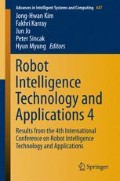Abstract
In this paper, we advance the thesis that educational robots can make a much larger contribution in the classroom than has hitherto been the case. However, to realise this potential, it is necessary to supply teachers with detailed guides for classroom robotic student activities for achieving specific curricular learning objectives. As illustration, we describe in detail three activities that use the capabilities of the inexpensive smartphone-based mobile robot Zorro developed by us.
Access this chapter
Tax calculation will be finalised at checkout
Purchases are for personal use only
Notes
- 1.
A floor turtle is a real robot moving on the floor as opposed to the LOGO-simulated turtle, which moves on the computer screen to do line drawings.
- 2.
This is because the motor also acts as a generator producing a voltage, the counter-electromotive force (EMF), that opposes the applied voltage, thereby diminishing the current through the motor.
References
cyberneticzoo.com: 1969 the logo turtle, Seymour Papert, Marvin Minskyetal. http://cyberneticzoo.com/cyberneticanimals/1969-the-logo-turtle-seymourpapert-marvin-minsky-et-al-american/. Accessed 11 June 2015
Ducasse, S.: Squeak, Learning Programming with Robots. Apress (2005)
Flot, J., Shoop, R.: Foregrounding math, engineering, and computer science using robotics. In: Presentation given at the Technology Education and Engineering Association of Pennsylvania Annual Conference (2013)
Papert, S.: Mindstorms: Children, Computers, and Powerful Ideas. Basic Books (1993). https://books.google.co.nz/books?id=AP8WBQAAQBAJH. Sekane, Z.S.: Localizing Objects during Robot SLAM in Semi-Dynamic Environments. In: IEEE Proceedings of the 2008 International Conference on Advanced Intelligent Mechatronics. ASME (2008)
Tetzlaff, T., Zandian, R., Drueppel, L., Witkowski, U.: Smartphone controlled robot platform for robot soccer and edutainment. In: Kim, J.H. (ed) Robot Intelligence Technology and Applications, vol. 3, pp. 505–518. Advances in Intelligent Systems and Computing, Springer (2015)
Author information
Authors and Affiliations
Corresponding author
Editor information
Editors and Affiliations
Rights and permissions
Copyright information
© 2017 Springer International Publishing Switzerland
About this paper
Cite this paper
Sitte, J., Witkowski, U., Zandian, R. (2017). Learning with Small Autonomous Robots. In: Kim, JH., Karray, F., Jo, J., Sincak, P., Myung, H. (eds) Robot Intelligence Technology and Applications 4. Advances in Intelligent Systems and Computing, vol 447. Springer, Cham. https://doi.org/10.1007/978-3-319-31293-4_28
Download citation
DOI: https://doi.org/10.1007/978-3-319-31293-4_28
Published:
Publisher Name: Springer, Cham
Print ISBN: 978-3-319-31291-0
Online ISBN: 978-3-319-31293-4
eBook Packages: EngineeringEngineering (R0)

